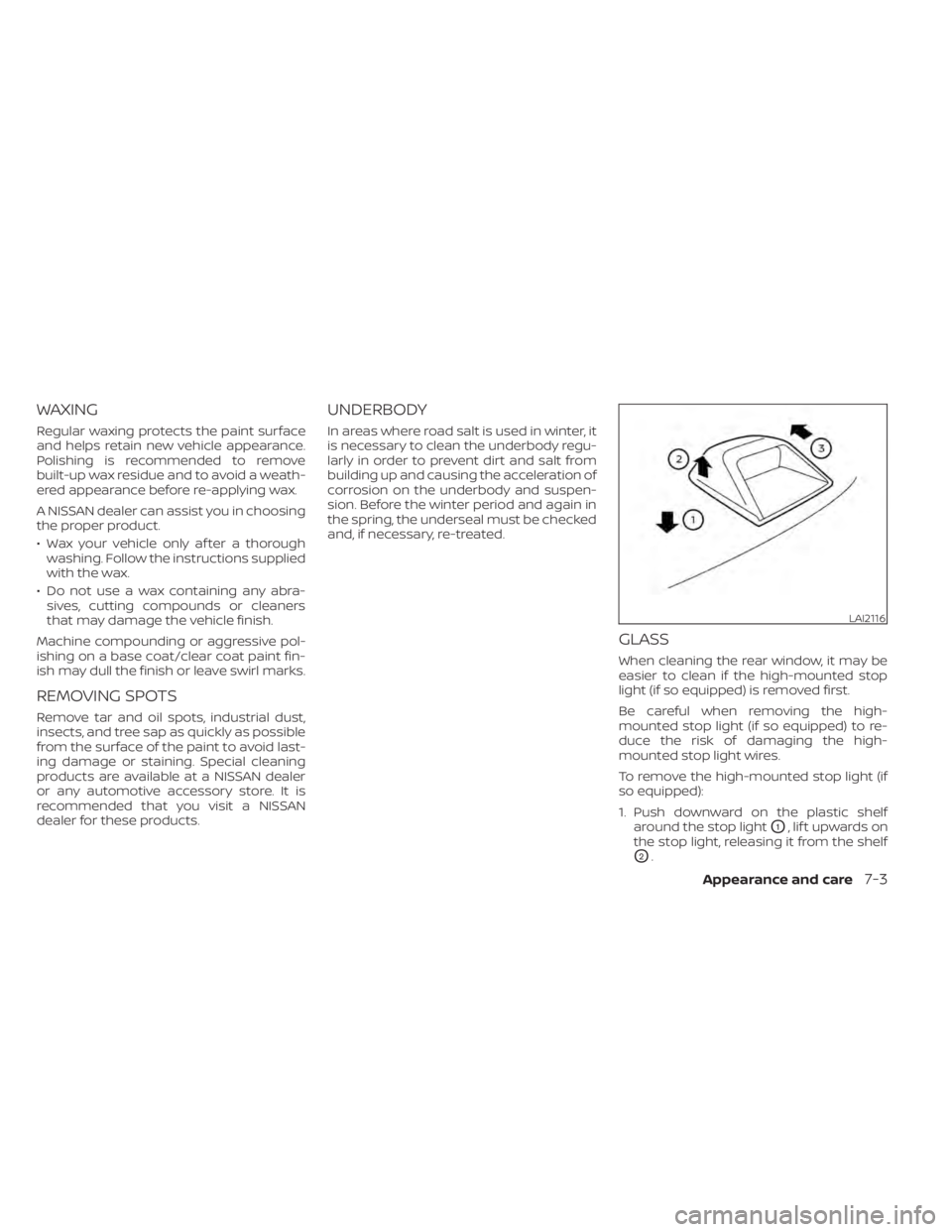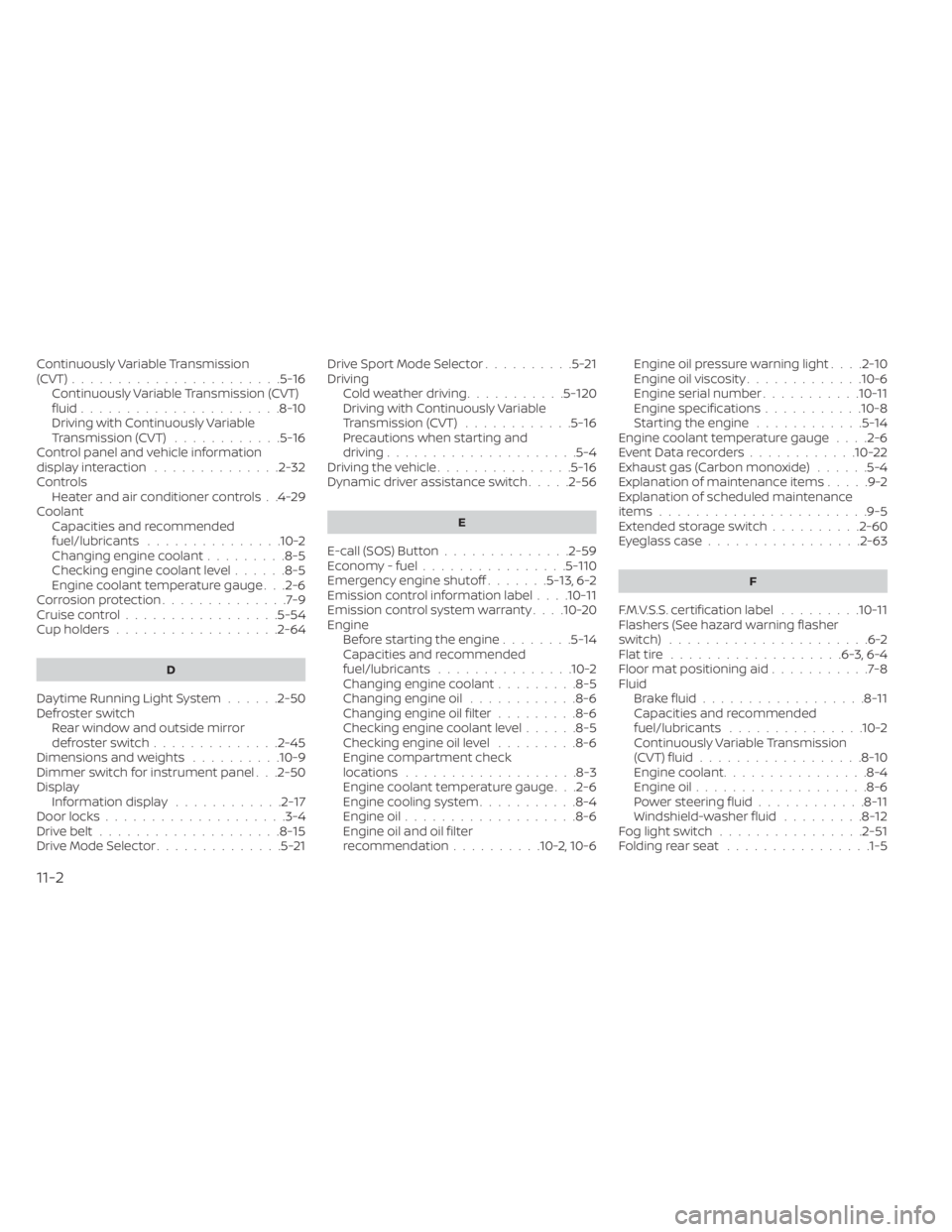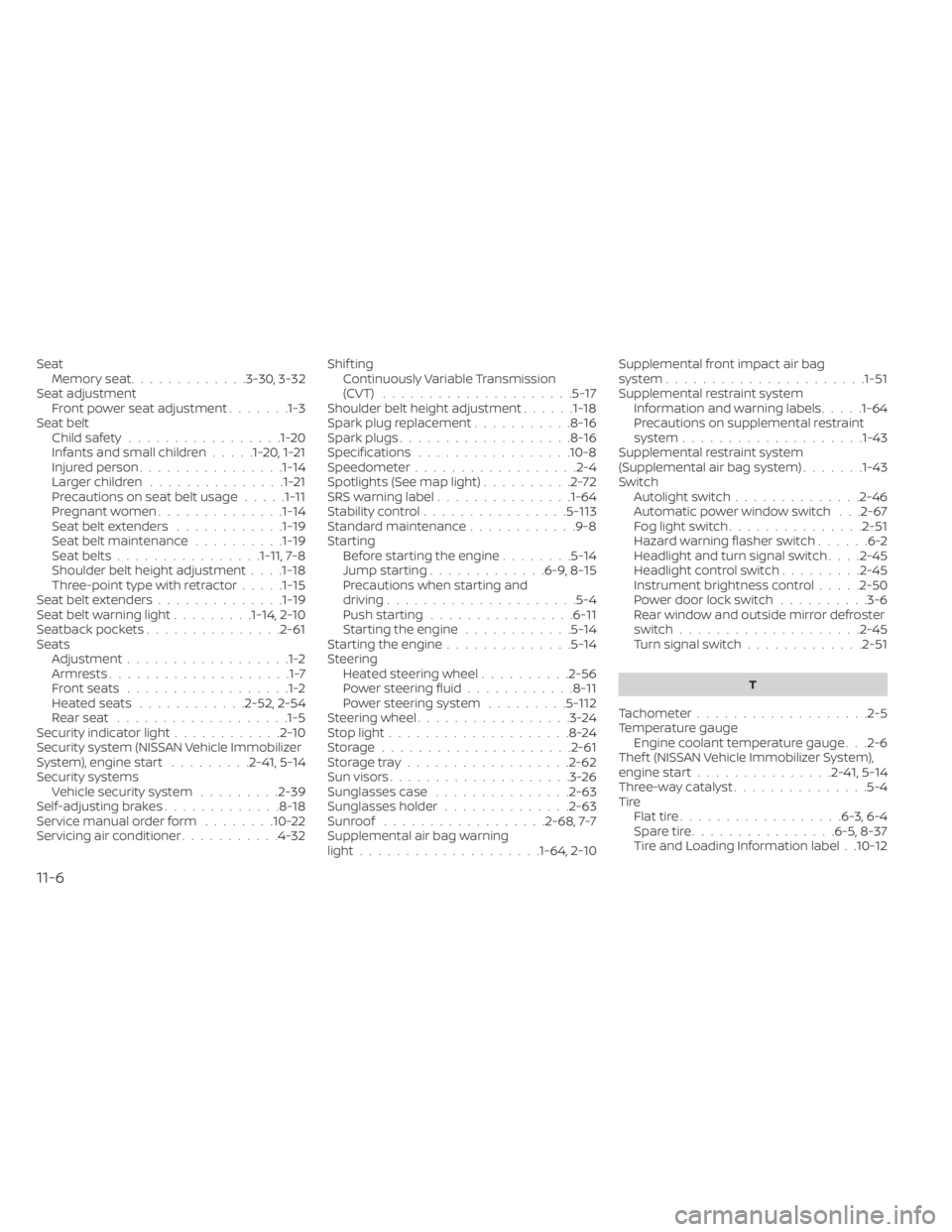window NISSAN MAXIMA 2021 Owner´s Manual
[x] Cancel search | Manufacturer: NISSAN, Model Year: 2021, Model line: MAXIMA, Model: NISSAN MAXIMA 2021Pages: 476, PDF Size: 3.32 MB
Page 363 of 476

CAUTION
• Continuously Variable Transmission
(CVT) models cannot be push-
started or tow-started. Attempting
to do so may cause transmission
damage.
• Do not push start this vehicle. The
three-way catalyst may be
damaged. If your vehicle is overheating (indicated by
an extremely high temperature gauge
reading) or if you feel a lack of engine
power, detect abnormal noise, etc., take the
following steps.
WARNING
• Do not continue to drive if your ve-
hicle overheats. Doing so could cause
engine damage or a vehicle fire.
• To avoid the danger of being scalded,
never remove the radiator cap while
the engine is still hot. When the radia-
tor cap is removed, pressurized hot
water will spurt out, possibly causing
serious injury.
• Do not open the hood if steam is
coming out.
1. Move the vehicle safely off the road, ap- ply the parking brake and move the shif t
lever to P (Park).
Do not stop the engine.
2. Turn off the air conditioner. Open all the windows, move the heater or air condi-
tioner temperature control to maximum
hot and fan control to high speed. 3. Get out of the vehicle. Look and listen for
steam or coolant escaping from the ra-
diator before opening the hood. (If
steam or coolant is escaping, turn off
the engine.) Do not open the hood fur-
ther until no steam or coolant can be
seen.
4. Open the engine hood.
WARNING
If steam or water is coming from the
engine, stand clear to prevent getting
burned.
5. Visually check drive belts for damage or looseness. Also check if the cooling fan
is running. The radiator hoses and radia-
tor should not leak water. If coolant is
leaking, the water pump belt is missing
or loose, or the cooling fan does not run,
stop the engine.
WARNING
Be careful not to allow your hands, hair,
jewelry or clothing to come into con-
tact with, or get caught in, engine belts
or the engine cooling fan. The engine
cooling fan can start at any time.
PUSH STARTING IF YOUR VEHICLE OVERHEATS
In case of emergency6-11
Page 369 of 476

WAXING
Regular waxing protects the paint surface
and helps retain new vehicle appearance.
Polishing is recommended to remove
built-up wax residue and to avoid a weath-
ered appearance before re-applying wax.
A NISSAN dealer can assist you in choosing
the proper product.
• Wax your vehicle only af ter a thoroughwashing. Follow the instructions supplied
with the wax.
• Do not use a wax containing any abra- sives, cutting compounds or cleaners
that may damage the vehicle finish.
Machine compounding or aggressive pol-
ishing on a base coat/clear coat paint fin-
ish may dull the finish or leave swirl marks.
REMOVING SPOTS
Remove tar and oil spots, industrial dust,
insects, and tree sap as quickly as possible
from the surface of the paint to avoid last-
ing damage or staining. Special cleaning
products are available at a NISSAN dealer
or any automotive accessory store. It is
recommended that you visit a NISSAN
dealer for these products.
UNDERBODY
In areas where road salt is used in winter, it
is necessary to clean the underbody regu-
larly in order to prevent dirt and salt from
building up and causing the acceleration of
corrosion on the underbody and suspen-
sion. Before the winter period and again in
the spring, the underseal must be checked
and, if necessary, re-treated.
GLASS
When cleaning the rear window, it may be
easier to clean if the high-mounted stop
light (if so equipped) is removed first.
Be careful when removing the high-
mounted stop light (if so equipped) to re-
duce the risk of damaging the high-
mounted stop light wires.
To remove the high-mounted stop light (if
so equipped):
1. Push downward on the plastic shelf around the stop light
O1,liftupwardson
the stop light, releasing it from the shelf
O2.
LAI2116
Appearance and care7-3
Page 370 of 476

2. Once it is released from the shelf, gentlypull the stop light towards the rear seat-
back
O3.
The high-mounted stop light must be
properly reinstalled before driving your
vehicle.
Use glass cleaner to remove smoke and
dust film from the glass surfaces. It is nor-
mal for glass to become coated with a film
af ter the vehicle is parked in the hot sun.
Glass cleaner and a sof t cloth will easily
remove this film.
To reinstall the high-mounted stop light,
reverse steps
O3, thenO2.
CAUTION
When cleaning the inside of the win-
dows, do not use sharp-edged tools,
abrasive cleaners or chlorine-based
disinfectant cleaners. They could dam-
age the electrical conductors, radio an-
tenna elements or rear window defog-
ger elements.
ALUMINUM ALLOY WHEELS
Wash the wheels regularly with a sponge
dampened in a mild soap solution, espe-
cially during winter months in areas where
road salt is used. If not removed, road salt
can discolor the wheels.
CAUTION
Follow the directions below to avoid
staining or discoloring the wheels:
• Do not use a cleaner that uses strong
acid or alkali contents to clean the
wheels.
• Do not apply wheel cleaners to the
wheels when they are hot. The wheel
temperature should be the same as
ambient temperature.
• Rinse the wheel to completely re-
move the cleaner within 15 minutes
af ter the cleaner is applied.
CHROME PARTS
Clean all chrome parts regularly with a
non-abrasive chrome polish to maintain
the finish.
TIRE DRESSINGS
NISSAN does not recommend the use of
tire dressings. Tire manufacturers apply a
coating to the tires to help reduce discolor-
ation of the rubber. If a tire dressing is ap-
plied to the tires, it may react with the coat-
ing and form a compound. This compound
may come off the tire while driving and
stain the vehicle paint.
If you choose to use a tire dressing, take the
following precautions:
• Use a water-based tire dressing. The coating on the tire dissolves more easily
than with an oil-based tire dressing.
• Apply a light coat of tire dressing to help prevent it from entering the tire tread/
grooves (where it would be difficult to
remove).
• Wipe off excess tire dressing using a dry towel. Make sure the tire dressing is com-
pletely removed from the tire
tread/grooves.
• Allow the tire dressing to dry as recom- mended by the tire dressing
manufacturer.
7-4Appearance and care
Page 461 of 476

11 Index
A
Active noise cancellationActive sound enhancement......5-121Active Ride Control (ARC).........5-116Air bag (See supplemental restraint
system).................... .1-43Air bag system
Front (See supplemental front impact air
bag system)
................1-51Air bag warning light.........1-64, 2-10Air bag warning light,
supplemental.............1-64, 2-10Air cleaner...................8-16Air cleaner housing filter..........8-16Air conditionerAir conditioner operation........4-29Air conditioner specification label. .10-12Air conditioner system refrigerant
recommendations.........10-2, 10-7Air conditioner system refrigerant and oil
recommendations.........10-2, 10-7Heater and air conditioner (automatic)
(if so equipped)..............4-28Heater and air conditioner controls.4-29Servicing air conditioner........4-32Alarm system (See vehicle security
system)................... .2-39Anchor point locations...........1-27Antenna....................4-32Antifreeze...................5-120
Armrests.....................1-7Autolight switch...............2-46Automatic
Automatic power window switch. . .2-67Automatic anti-glare inside mirror. . . .3-27Automatic door locks.............3-6Automatic Emergency Braking
(AEB)....................2-11,2-15Automatic Emergency Braking (AEB) with
Pedestrian Detection............5-85
B
Battery.................5- 120, 8-13Charge warning light...........2-10Battery replacement.............8-21Key fob...................8-21NISSAN Intelligent Key®.........8-22Before starting the engine.........5-14Belt (See drive belt)..............8-15Blind Spot Warning (BSW)..........5-36Booster seats.................1-40Brake
Brake fluid..................8-11Brake light (See stop light).......8-24Brake warning light............2-9Brake wear indicators.......2-16,8-18Parking brake operation.........5-21Self-adjusting brakes...........8-18Brake fluid...................8-11
Brakes.....................8-18Break-in schedule.............5-109Brightness controlInstrument panel.............2-50Bulb check/instrument panel........2-9Bulb replacement..............8-24
C
C.M.V.S.S. certification label.........10-11Capacities and recommended
fuel/lubricants................10-2Car phone or CB radio...........4-33Cargo (See vehicle loading
information)................ .10-14Check tire pressure.............2-29Child restraints.......1-20,1-21,1-22,1-24LATCH (Lower Anchors and Tethers for
CHildren) System.............1-24Precautions on child
restraints...........1-29,1-35, 1-40Top tether strap anchor point
locations..................1-27Child safety rear door lock..........3-6Cleaning exterior and interior.....7-2,7-5Climate control seat switch........2-52Cold weather driving............5-120Console box................. .2-63Console light.................2-72
Page 462 of 476

Continuously Variable Transmission
(CVT).......................5-16Continuously Variable Transmission (CVT)
fluid......................8-10Driving with Continuously Variable
Transmission (CVT)............5-16Control panel and vehicle information
display interaction..............2-32ControlsHeater and air conditioner controls. .4-29CoolantCapacities and recommended
fuel/lubricants
...............10-2Changing engine coolant.........8-5Checking engine coolant level......8-5Engine coolant temperature gauge. . .2-6Corrosion protection..............7-9Cruise control................ .5-54Cup holders................. .2-64
D
Daytime Running Light System......2-50Defroster switch
Rear window and outside mirror
defroster switch
..............2-45Dimensions and weights..........10-9Dimmer switch for instrument panel. . .2-50DisplayInformation display............2-17Door locks................... .3-4Drive belt....................8-15Drive Mode Selector..............5-21
Drive Sport Mode Selector..........5-21Driving
Cold weather driving...........5-120Driving with Continuously Variable
Transmission (CVT)............5-16Precautions when starting and
driving.................... .5-4Driving the vehicle...............5-16Dynamic driver assistance switch.....2-56
E
E-call (SOS) Button..............2-59Economy - fuel................5-110Emergency engine shutoff.......5-13,6-2Emission control information label. . . .10-11Emission control system warranty. . . .10-20Engine
Before starting the engine........5-14Capacities and recommended
fuel/lubricants...............10-2Changing engine coolant.........8-5Changing engine oil............8-6Changing engine oil filter.........8-6Checking engine coolant level......8-5Checking engine oil level.........8-6Engine compartment check
locations.................. .8-3Engine coolant temperature gauge. . .2-6Engine cooling system...........8-4Engine oil...................8-6Engine oil and oil filter
recommendation..........10-2, 10-6
Engine oil pressure warning light. . . .2-10Engine oil viscosity.............10-6Engine serial number...........10-11Engine specifications...........10-8Starting the engine............5-14Engine coolant temperature gauge. . . .2-6Event Data recorders............10-22Exhaust gas (Carbon monoxide)......5-4Explanation of maintenance items.....9-2Explanation of scheduled maintenance
items...................... .9-5Extended storage switch..........2-60Eyeglass case.................2-63
F
F.M.V.S.S. certification label.........10-11Flashers (See hazard warning flasher
switch)......................6-2Flat tire.................. .6-3, 6-4Floor mat positioning aid...........7-8Fluid
Brake fluid..................8-11Capacities and recommended
fuel/lubricants...............10-2Continuously Variable Transmission
(CVT) fluid..................8-10Engine coolant................8-4Engine oil.................. .8-6Power steering fluid............8-11Windshield-washer fluid.........8-12Fog light switch................2-51Folding rear seat................1-5
11-2
Page 465 of 476

N
NISSAN Intelligent Key®..........3-2,3-7NISSAN Intelligent Key® battery discharge
indicator.....................5-13NISSAN Vehicle Immobilizer
System..................2-41, 5-14NissanConnect® Owner's Manual......4-2
O
Octane rating (See fuel octane rating). .10-5Odometer................... .2-5Oil
Capacities and recommended
fuel/lubricants
...............10-2Changing engine oil............8-6Changing engine oil filter.........8-6Checking engine oil level.........8-6Engine oil.................. .8-6Engine oil and oil filter
recommendation..........10-2, 10-6Engine oil viscosity.............10-6Outside mirror control............3-28Outside mirrors................3-28Overhead sunglasses holder........2-63Overheat
If your vehicle overheats.........6-11Owner's manual order form........10-22Owner's manual/service manual order
information................. .10-22
P
Parking
Parking brake operation.........5-21Parking/parking on hills.........5-111Parking brake..................5-21Personal lights.................2-73PowerPower door locks..............3-6Power outlet................2-59Powerrearwindows...........2-66Power steering fluid............8-11Power steering system.........5-112Power windows..............2-65Rear power windows...........2-66Power outlet................. .2-59Power steering................5-112Power steering fluid..............8-11Precautions
Maintenance precautions.........8-2Precautions on booster
seats...............1-29, 1-35, 1-40Precautions on child
restraints............1-29,1-35, 1-40Precautions on seat belt usage.....1-11Precautions on supplemental restraint
system................... .1-43Precautions when starting and driving.5-4Push starting..................6-11
R
Radio
Car phone or CB radio..........4-33Rain-sensing auto wiper system.....2-44Readiness for inspection maintenance (I/M)
test...................... .10-21Rear Automatic Braking (RAB).......5-80Rear Cross Traffic Alert (RCTA).......5-45Rear Door Alert.........2-26,2-27,2-58Rear power sunshade............2-70Rear power windows.............2-66Rear seat.................... .1-5Rear sun shade................2-70Rear window and outside mirror defroster
switch..................... .2-45RearView Monitor................4-3Recommended Fluids............10-2Recorders
Event Data................ .10-22Refrigerant recommendation. . . .10-2, 10-7Registering a vehicle in another
country.................... .10-10Remote Engine Start..........3-18,5-15Reporting safety defects (US only). . . .10-20
S
Safety
Child safety rear door lock.........3-6Child seat belts.....1-22,1-29, 1-35, 1-40Reporting safety defects (US only). .10-20
11-5
Page 466 of 476

SeatMemory seat.............3-30, 3-32Seat adjustmentFront power seat adjustment.......1-3Seat beltChild safety.................1-20Infants and small children.....1-20,1-21Injured person................1-14Larger children...............1-21Precautions on seat belt usage.....1-11Pregnant women..............1-14Seat belt extenders............1-19Seat belt maintenance..........1-19Seat belts................1-11,7-8Shoulder belt height adjustment. . . .1-18Three-point type with retractor.....1-15Seat belt extenders..............1-19Seat belt warning light.........1-14,2-10Seatback pockets...............2-61SeatsAdjustment..................1-2Armrests....................1-7Front seats..................1-2Heated seats............2-52, 2-54Rear seat.................. .1-5Security indicator light............2-10Security system (NISSAN Vehicle Immobilizer
System), engine start.........2-41, 5-14Security systems
Vehicle security system.........2-39Self-adjusting brakes.............8-18Service manual order form........10-22Servicing air conditioner...........4-32
Shif tingContinuously Variable Transmission
(CVT)
.....................5-17Shoulder belt height adjustment......1-18Spark plug replacement...........8-16Spark plugs...................8-16Specifications................ .10-8Speedometer................. .2-4Spotlights (See map light)..........2-72SRS warning label...............1-64Stability control................5-113Standard maintenance............9-8Starting
Before starting the engine........5-14Jump starting.............6-9, 8-15Precautions when starting and
driving.................... .5-4Push starting................6-11Starting the engine............5-14Starting the engine..............5-14Steering
Heated steering wheel..........2-56Power steering fluid............8-11Power steering system.........5-112Steering wheel.................3-24Stop light....................8-24Storage.................... .2-61Storage tray..................2-62Sun visors....................3-26Sunglasses case...............2-63Sunglasses holder..............2-63Sunroof..................2-68, 7-7Supplemental air bag warning
light................... .1-64, 2-10
Supplemental front impact air bag
system..................... .1-51Supplemental restraint system
Information and warning labels.....1-64Precautions on supplemental restraint
system................... .1-43Supplemental restraint system
(Supplemental air bag system).......1-43Switch
Autolight switch..............2-46Automatic power window switch. . .2-67Fog light switch...............2-51Hazard warning flasher switch......6-2Headlight and turn signal switch. . . .2-45Headlight control switch.........2-45Instrument brightness control.....2-50Power door lock switch..........3-6Rear window and outside mirror defroster
switch................... .2-45Turn signal switch.............2-51
T
Tachometer...................2-5Temperature gauge
Engine coolant temperature gauge. . .2-6Thef t (NISSAN Vehicle Immobilizer System),
engine start...............2-41, 5-14Three-way catalyst...............5-4TireFlat tire................. .6-3, 6-4Spare tire................6-5, 8-37Tire and Loading Information label. .10-12
11-6
Page 468 of 476

Windows....................2-65Locking passengers' windows.....2-67Powerrearwindows...........2-66Power windows..............2-65Rear power windows...........2-66Windshield wiper blades...........8-17Windshield-washer fluid...........8-12Wiper
Wiper blades................8-17Wiper and washer switch..........2-42
11-8